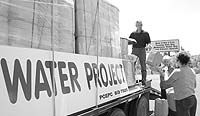| Brent Barker of Pinnacle Sports hands Joyce Daniels and water storage chairperson Rita Dunn some of the containers that residents can purchase to store water properly. |
On hot days like these it is nice to be able to have cool water run over ones head or take a dip in a swimming pool. And of course a cold cool drink of water doesn’t hurt either.
But just imagine if that drink wasn’t available. Imagine a major catastrophe where all culinary water is cut off and it’s either drink water from tainted sources or don’t drink at all. It’s a possibility, and the Price City Emergency Planning Committee is urging citizens to think about it, and then do something about it.
“We are trying to make people aware that having water storage is as important as any other emergency measure they can take around their homes,” said Joyce Daniels of the PCEPC. “And the way water is stored for emergencies is important too.”
To that end the PCEPC has teamed up with Pinnacle Sports to sell to the public five gallon storage containers at a low cost. These containers are ideal to store water in because that is what they are manufactured for and they are portable.
While a cutoff in water is seemingly impossible a major flood, a broken water line, earthquake or a national emergency could cause water that comes from taps to stop flowing or render it undrinkable. The Federal Emergency Management Administration and the Red Cross strongly advise that each person in a family should have at least 14 gallons of potable water stored for them just in case of a problem.
During the millennium scare many people did store water, food and other items, but that was five years ago and a lot of the preparedness people did then has either dwindled away or their emergency storage is old. Many went out and bought big water tanks so they would have enough to get through an emergency. Problem is, if there is an evacuation, they can’t take those tanks with them. At least some water storage needs to be portable.
In an emergency, drinking water should never be rationed. So it is important to store at least one gallon of it for each person per day. Individual needs vary, because people at certain ages need more water. In addition water usage is determined by the persons physical condition and the climate at the time of the emergency. Generally very hot temperatures double the amount of water a person needs to stay hydrated.
In addition pregnant women, people who are ill and children often need more water as well.
The PCEPC recommends that people use the proper storage vessels for water. Here are some steps for putting water in food-grade containers, which are the type that are being sold at Pinnacle Sports.
•Rinse the food-grad container with a weak bleach solution (1:10) and always use unscented 5 percent bleach to do so.) After that rinse them out again with clean water.
•Fill the container with tap water. If well water is used to fill them it must be further treated.
•Seal the containers tightly and date them. Store them in a cool, dark place.
•Water should only be stored for six months. Then the containers need to be emptied and the process repeated.
Residents should also store water in non-food-grade containers that can be used for washing, bathing, flushing toilets, etc. A good recommendation is to fill unrinsed liquid detergent bottles for laundry use if it is needed.
The low cost food grade containers will go on sale Monday, July 18.

